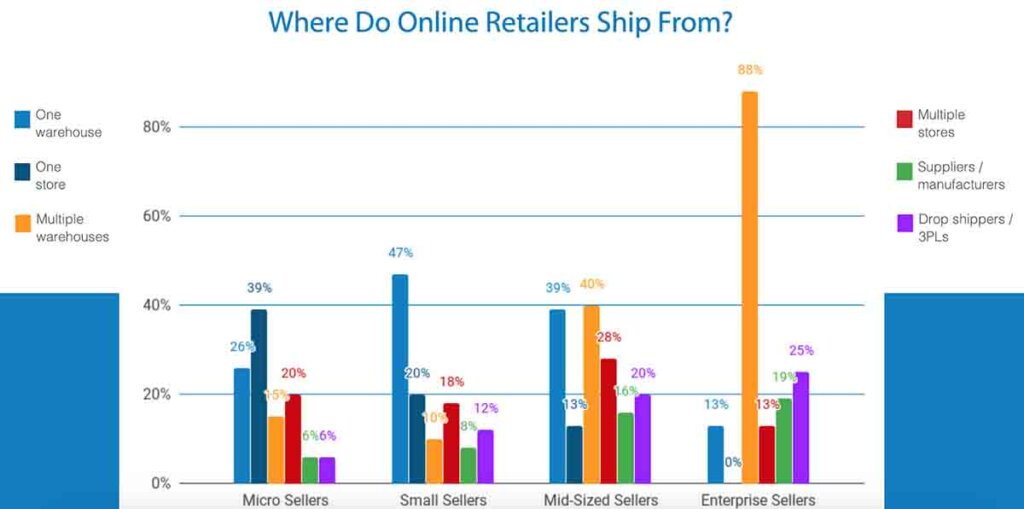eCommerce warehousing is a often overlooked by small to mid-size eCommerce stores. It’s tempting to focus time and attention on eCommerce marketing and increasing product page conversion rates.
Don’t be one of those sellers!
If you have dreams of your eCommerce store outgrowing your garage, it’s time to embrace eCommerce warehousing. Read on to learn about the different types of eCommerce warehouses and the benefits of each one.
What is eCommerce warehousing?
eCommerce warehousing is the process of storing your goods before they’re sold online.
eCommerce warehousing is more than just a place to keep your stock, however. It’s also about storing your products in a safe and secure manner, tracking the in-stock status of your entire store inventory and keeping track of the movement of your items.
eCommerce warehouse management is a job in itself. As you likely know first-hand, it becomes exceedingly difficult to manage warehousing on your own, especially as your store grows. That’s why many eCommerce store owners look to the professional eCommerce warehouses to manage it for them.
Different types of warehouses for eCommerce
All eCommerce warehouses serve the same basic functions, but there are several different types. Each offers distinct benefits for different types of eCommerce business.
1. Private warehouses
Private warehouses are owned by private wholesalers, distributors, or larger retailers who rent space to smaller sellers. These tend to have more advanced eCommerce warehouse management systems, and may be more costly as a result. In the U.S. alone, private warehouses have grown nearly 20% over the past decade.
2. Public warehouses
Public warehouses are similar to private warehouses, except that they’re owned by governmental agencies who loan space to businesses and individuals. These can be basic in terms of functionality, but they cover the basics and are affordable.
3. Government warehouses
Government warehouses are another affordable option. Unlike public warehouses, the managing agency has greater control. This often results in increased security, which is ideal for stores who sell high-value items. However, if you default on your rent, they can sell your products to recoup their costs.
4. Distribution centers
Distribution centers are designed for maximum efficiency and warehouse fulfillment. Products tend to come and go rapidly within these centers, rather than being stored for long periods of time. They’re commonly used by food sellers and others who need to move inventory quickly. Like private warehouses, DCs are also growing, both in number as well as in square footage.
5. Smart warehouses
Smart warehouses take the efficiency of a distribution center to another level. They use artificial intelligence to streamline the entire eCommerce warehouse process and automate as much of it as possible. This can be done by using drones and software for eCommerce packaging, shipping, and storing. One-third of warehouses are already using smart technology, or planning to in the near future.
Amazon’s fulfillment centers are a prime example of a smart warehouse:

6. Consolidated warehouses
Consolidated warehouses offer smaller businesses a more affordable eCommerce warehouse fulfillment option. These warehouses consolidate multiple shipments from different sellers into large shipments that get sent to the same place.
7. Cooperative warehouses
Cooperative warehouses are owned by their members, who can store their products for reduced rates. Non-members can store products in co-op warehouses as well, but they’ll pay the full rate. Typically, these are managed by sellers who share a vertical and have similar warehousing needs.
8. Bonded warehouses
Bonded warehouses cater to importers who need a place to store their imported products duty-free until they’ve been purchased. They allow importers to store products for longer periods of time without having to pay custom duties.
The benefits of eCommerce warehousing
There are many benefits to eCommerce warehousing, no matter the size of your online store. Here are three key benefits to consider:
1. Offer faster shipping and win more customers
Did you know that for a majority of online shoppers, shipping speed is just as important as free shipping? Nearly 80% of shoppers now view free two-day shipping as “the norm of online retail.”67% of shoppers expect to receive their orders within two days or less. Only a third are willing to wait longer than that:

By outsourcing fulfillment to an eCommerce warehouse, you can meet those customer expectations and get your goods delivered to them quickly. This can deepen your customer loyalty, and make your store more attractive to would-be buyers.
If you are a Seller-Fulfilled Prime merchant, fast shipping isn’t optional; it’s a requirement. 99% of your orders must meet that two-day shipping window.
2. Improve inventory management and stay organized
62% of small- to medium-sized e-retailers report “human error from manual process management” is their biggest inventory issue:

With an eCommerce warehouse, that problem goes away. From top to bottom, eCommerce warehouses are built to store products safely and securely, keep them organized, and ship and distribute them as quickly as possible.
By using an eCommerce warehouse, you get to benefit from that purpose-driven construction. You know that your products won’t be stolen, and they won’t be damaged by temperature changes.
You also get to benefit from their use of eCommerce warehouse management system software. These systems keep detailed records of your current inventory — for all your product variations — and analyze demand levels throughout the year. For you, that means no more lost inventory, no more shipping the wrong product by accident, and no more stock-outs.
3. Devote more time to marketing and growing your eCommerce store
The eCommerce warehouse fulfillment process is a beast all its own. You risk eating up a lot of time, which can be better spent on eCommerce marketing, sourcing new products, customer service and increasing your revenue.
Many sellers delay using a warehouse for too long, for fear of using up precious budget. This concern is valid, but in reality the benefits of an eCommerce warehouse outweigh the cost for growing sellers.
The ability to fulfill orders faster, ensure the security of your products and manage a growing inventory will help you scale. There’s a clear correlation between store size and warehouse usage. In order to grow, you need to warehouse.

What to consider when using an eCommerce warehouse
When choosing an eCommerce warehousing solution, ask yourself these questions to find the right one for you:
1. What kind of products do you sell?
International sellers may benefit from the duty-free storage of a bonded warehouse. However, those who sell perishable items often prefer distribution centers. A B2B wholesaler could use a consolidated warehouse, while a niche eCommerce store may enjoy more affordable rates with a public or co-op warehouse.
2. How much can you afford to spend on logistics?
The average eCommerce seller spends 11% of their sales on logistics, with transportation and inventory being the largest contributors. As you evaluate eCommerce warehousing solutions, ensure you consider where else you can shift your budget to lower your logistics costs.
3. Does the warehouse logistics system work with your other eCommerce software?
To prevent delays and overstocking or understocking, you need all of your systems to communicate directly. An eCommerce helpdesk like eDesk supports easy integration with your warehouse inventory management system, allowing you to better assist customers and answer questions about their order status.

4. Can the warehouse guarantee fast shipping?
Increasingly customers increasingly expect 2-day delivery times or shorter. Ask about the warehouse’s technology. Batch picking, multi-order support, and packing drones can all speed up shipment times. Do they have contingency plans for hiring seasonal and temp workers to meet demand during order spikes?




